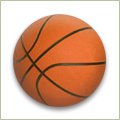
No, I'm not talking about going to Infinity and Beyond in the Nike Buzz Lightyear shoes.
It's "Nfinity", a company that claims "We Are Women's Sports" and recently got into the women's basketball shoe market.
A while back, I received an e-mail asking if I was familiar with their new shoe and what I thought of their claim that their shoe reduces the risk of ACL injuries.
First I went to their website to learn more.
It's slick and user-friendly and touts the Nfinity basketball shoe (currently priced at $119/pair), which has BioniQ Technology designed to address "the pronounced Q angle(the angle between hip and knee, which increases the likelihood of ACL injuries)."
In a previous blog entry (What Female Basketball Players Kneed to Know), I discussed the problem of ACL injuries in female players and gave a few links to some resources to help girls try and reduce their risk. Could a shoe help as well?
I've long agreed that we need more basketball shoes that are made specifically for girls (better fit in the heel, more streamlined for the female foot) and I applaud this company's attempts to fill that need.
Yet I wonder - How much $$ are they spending on research and how much $$ are they spending on marketing? (They also have a neat commercial on you-tube, featuring Nikki Blue.) It's something you have to ask about any basketball shoe product, whether it's from Nfinity, Nike, Adidas or Reebok.
And most importantly - will it work to reduce the risk of an ACL injury?
To investigate, I asked some of my colleagues who study ACL injuries, sports biomechanics, and orthotics for sports about the Nfinity's basketball product. Some felt the BioniQ idea was just another gimmick to jack up the price of a shoe. Others felt that more research (prospective, randomized) should be done to determine its effectiveness.
The folks at Nfinity, in response to my e-mail, told me that their shoes are currently being tested at the University of Michigan. "As soon as we have conclusive results we can make them available." She also gave me links to several testimonials. While testimonials are nice, and are often used to sell products, they won't sway my vote.
To Nfinity and Beyond?
First, I'd like to hear the results of their research.
Then I'll decide if I'd go there.














